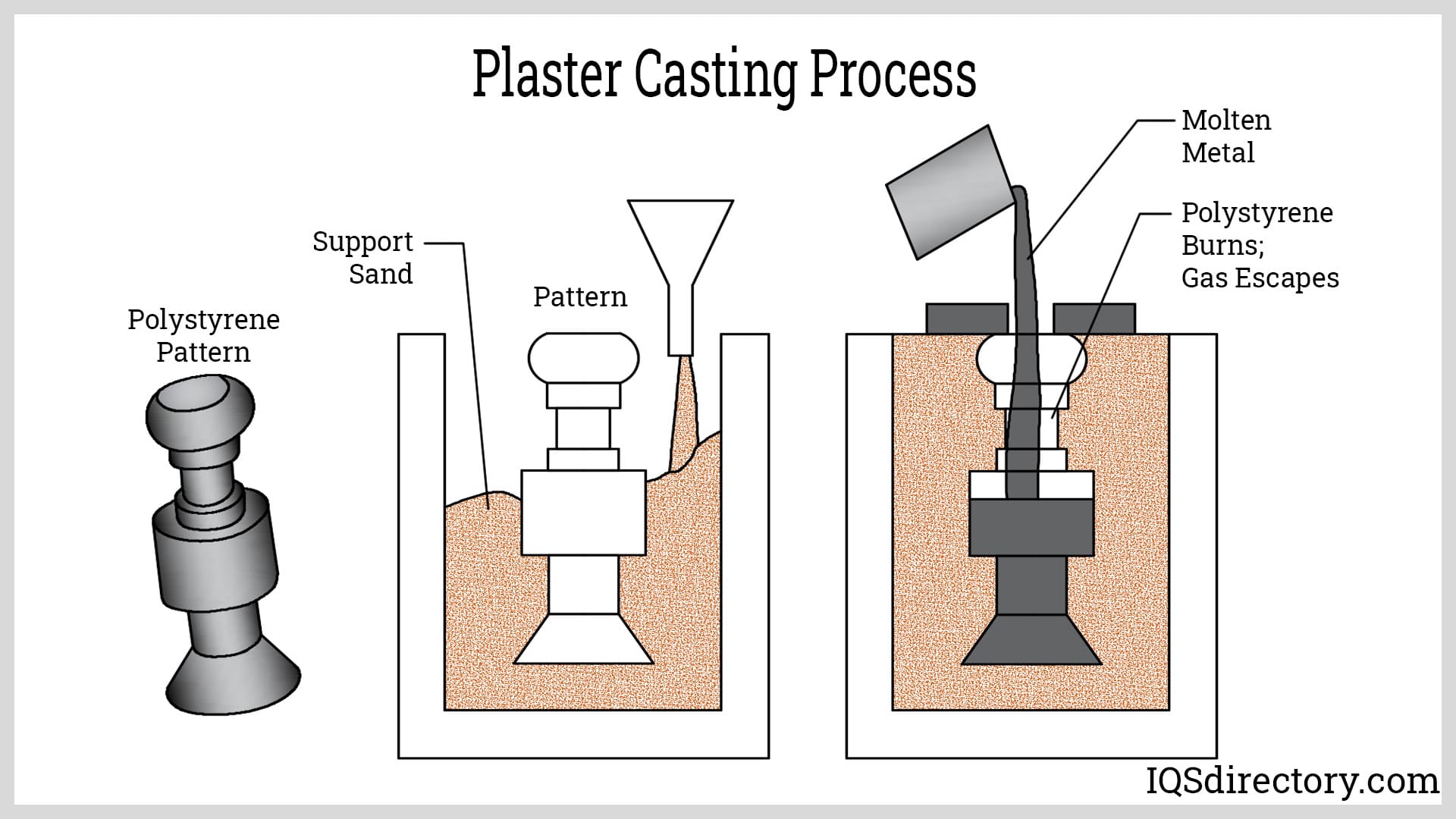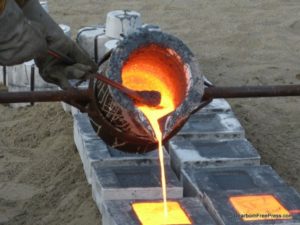Inside the world of Aluminum Foundry: modern casting solutions
Wiki Article
Understanding the Steel Castings Refine: A Comprehensive Guide for Beginners
The Metal Casting procedure is a basic method in manufacturing that changes molten metal into strong types. Beginners need to grasp the numerous techniques involved, such as sand spreading and die spreading. Comprehending the materials, layout principles, and precaution is similarly vital. Each element plays a vital role in attaining successful end results. As one navigates these intricacies, the inquiry of how to maximize each action for improved outcomes ends up being increasingly relevant.The Essentials of Metal Casting
Although Metal Casting has actually progressed over centuries, its fundamental concepts remain constant and integral to the production process. At its core, Metal Casting involves the makeover of molten steel into strong objects with numerous methods. The procedure begins with the production of a mold, which specifies the shape of the end product. Once the mold and mildew is prepared, metal is heated up to its melting point and poured right into the dental caries. After cooling down, the metal strengthens, taking the form of the mold and mildew.There are several casting methods, including sand casting, financial investment spreading, and pass away spreading, each with unique advantages and applications. The option of method depends upon variables such as manufacturing volume, material type, and preferred precision. As soon as cast, the final item might go through added procedures like machining or surface area treatment to achieve the required finish and specifications. Comprehending these fundamentals is important for any individual curious about the area of Metal Casting.

Recognizing Materials Made Use Of in Metal Casting
Products play a necessary role in the Metal Casting procedure, affecting the end product's properties and efficiency. Various steels are utilized, consisting of aluminum, iron, steel, and bronze, each offering unique characteristics suited for details applications. Light weight aluminum is corrosion-resistant and light-weight, making it perfect for automotive parts. Iron, particularly cast iron, is preferred for its excellent wear resistance and durability. Steel gives high stamina and versatility, commonly used in heavy machinery parts. Bronze, recognized for its rust resistance and machinability, is commonly utilized in aquatic applications.In enhancement to the steels, various casting materials, such as sand, plaster, and ceramic, are used to produce molds. Sand casting, the most common technique, makes use of silica sand as a result of its thermal security and ability to develop complex forms. Plaster and ceramic mold and mildews use better information however might need even more complicated processes. The option of products directly affects the effectiveness, expense, and high quality of the casting operation.
The Design Process: From Principle to Plan
The layout procedure in Metal Casting begins with the first idea advancement, where ideas are generated and assessed. This is followed by the application of CAD modeling techniques, permitting specific visualizations of the layout. Ultimately, the plan finalization steps assure that all requirements are precisely documented for production.First Idea Advancement
Initial principle advancement marks a vital stage in the Metal Casting process, where ideas change right into tangible layouts. Throughout this phase, developers work together with stakeholders and designers to brainstorm and fine-tune preliminary concepts. They take into consideration aspects such as functionality, looks, and manufacturability, making certain that the design meets the required requirements and performance criteria. Sketches and outlines are produced to visualize the ideas, permitting initial assessments of usefulness and cost-effectiveness. This stage likewise involves determining products and prospective spreading methods that straighten with the design objectives. Inevitably, preliminary principle development lays the foundation for an extensive plan, directing the succeeding phases of the spreading procedure and guaranteeing an effective shift from principle to fact.CAD Modeling Techniques
Transforming concepts into exact designs, CAD modeling techniques play a crucial role in the Metal Casting procedure. These strategies utilize advanced software program to create in-depth three-dimensional versions that accurately reflect the designated item. By using tools such as parametric modeling, solid modeling, and surface modeling, developers can adjust measurements and shapes with ease. CAD systems likewise assist in simulation and evaluation, allowing for the identification of potential defects prior to manufacturing starts. This aggressive method decreases product waste and enhances the layout for manufacturability. Additionally, CAD versions can be quickly changed, allowing fast versions based upon comments. Essentially, CAD modeling functions as the foundation of the style procedure, connecting the void in between preliminary ideas and the ultimate production-ready styles.Blueprint Finalization Steps
Following the creation of comprehensive CAD designs, the following stage includes blueprint finalization, which is vital in equating digital designs into workable prepare for manufacturing. This process begins with reviewing the CAD models for precision and conformity with specs. Once verified, the measurements, resistances, and material specifications are diligently described to ensure clearness. Including comments and notes helps communicate essential details regarding spreading procedures, surface finishes, and setting up demands. The settled blueprint undergoes a strenuous authorization process, often entailing cooperation with designers and production groups to attend to any potential issues. Alterations are made and authorizations acquired, the blueprint is formally released, offering as the fundamental paper for the subsequent phases of Metal Casting, consisting of pattern production and mold layout.The Steel Casting Methods Explained

Metal Casting strategies encompass a selection of approaches made use of to form liquified steel into desired forms. These techniques differ according to the kind of product, intricacy of the style, and production volume. Sand spreading is just one of one of the most typical techniques, involving the creation of a mold and mildew from sand to hold the liquified metal. Investment spreading, or lost-wax spreading, enables for complex designs by using a wax pattern that is dissolved. Pass away casting utilizes high-pressure injection of liquified metal right into a mold, appropriate for automation. Various other approaches include irreversible mold spreading, which uses multiple-use mold and mildews, and centrifugal spreading, where rotational pressures help in loading the mold and mildew. Each technique has its applications and benefits, making it important for manufacturers to pick the proper method based upon their certain needs and needs. Comprehending these techniques is essential for any person associated with the Metal Casting process.
Ending Up Processes: Enhancing Your Casted Item

Completing procedures play a crucial duty in boosting the quality and appearance of casted products. Numerous surface area therapy strategies, such as sprucing up and layer, Aluminum Foundry are used to improve sturdiness and visual appeals. Furthermore, high quality assessment techniques ensure that the final product meets defined criteria and efficiency demands.
Surface Treatment Strategies
A selection of surface area treatment techniques play an important role in boosting the top quality and durability of casted products. These techniques consist of techniques such as shot blasting, polishing, and coating. Shot blowing up properly eliminates surface blemishes, enhancing the aesthetic and functional attributes of the casting. Polishing gives a smooth finish, which is specifically crucial for decorative applications and parts needing minimal rubbing. Finishing techniques, such as electroplating or powder finish, offer added security against rust and wear, guaranteeing durability. Additionally, surface therapies can enhance attachment for subsequent procedures, such as painting or bonding. By utilizing these approaches, producers can attain exceptional surface area quality, which is important for the performance and life expectancy of Metal Casting in numerous applications.High Quality Examination Methods
Reliable quality assessment approaches are vital for assuring the integrity and performance of casted items after the finishing processes. Numerous strategies are employed to examine the top quality of Metal Casting, including aesthetic assessment, dimensional checks, and non-destructive testing (NDT) Visual assessment permits for the identification of surface problems, while dimensional checks assure that items fulfill specified tolerances. NDT techniques, such as ultrasonic testing and radiographic assessment, give much deeper insights into internal stability without damaging the castings. Furthermore, mechanical screening, such as tensile and solidity examinations, reviews product residential properties - Aluminum Castings. By utilizing a combination of these techniques, makers can improve item top quality and integrity, inevitably bring about greater customer fulfillment and minimized manufacturing expensesSecurity Considerations in Metal Casting
While the Metal Casting process provides various benefits, it also provides a series of safety and security dangers that need to be meticulously handled. Workers in casting facilities are exposed to heats, liquified metals, and dangerous materials, which can lead to extreme injuries if appropriate safety measures are not taken. Personal safety devices (PPE) such as heat-resistant gloves, face guards, and protective clothing is vital to decrease dangers.Additionally, the presence of fumes and dirt requires proper air flow systems to ensure air quality - Aluminum Castings. Normal training on security procedures is important for all employees to identify prospective hazards and react efficiently. Emergency treatments must be established, consisting of fire security steps and emergency treatment accessibility. Upkeep of devices and correct handling of materials additionally add to a more secure working environment. By focusing on these security factors to consider, Metal Casting operations can shield their workforce and keep efficient manufacturing procedures
Often Asked Inquiries
What Are the Environmental Effects of Metal Casting?
Metal Casting can bring about environmental effects such as air and water pollution, resource exhaustion, and power consumption. Furthermore, inappropriate waste management and discharges from shops add to environmental disruptions and wellness risks for close-by areas.How Do I Choose the Right Steel for Spreading?
To pick the right metal for casting, one need to consider elements such as mechanical properties, corrosion resistance, thermal conductivity, and expense. Examining the desired application and ecological conditions is important for suitable selection.What Are the Common Problems in Metal Casting?
Typical problems in Metal Casting include porosity, contraction, sand addition, and misruns. These issues often emerge from inappropriate material selection, poor style, or flaws in the spreading process, impacting the last product's top quality and efficiency.
How Can I Boost My Metal Casting Abilities?
To enhance Metal Casting abilities, one must practice continually, research study casting methods, evaluate previous tasks for flaws, seek comments from skilled wheels, and continuously trying out different products and techniques to boost efficiency and understanding.What Is the Price of Starting a Steel Casting Service?
Starting a metal spreading company commonly needs an initial investment of $5,000 to $50,000, depending upon devices, materials, and center expenses. Variables like area and scale can considerably affect total startup expenditures.The Metal Casting process is an essential strategy in manufacturing that changes molten steel into solid types. Newbies must understand the numerous methods involved, such as sand casting and pass away spreading. There are several casting methods, including sand casting, investment spreading, and pass away spreading, each with unique advantages and applications. Investment casting, or lost-wax spreading, permits for detailed designs by using a wax pattern that is melted away. Other techniques consist of irreversible mold and mildew spreading, which uses reusable mold and mildews, and centrifugal spreading, where rotational pressures help in loading the mold and mildew.
Report this wiki page